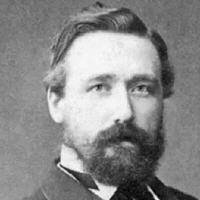
John William Godward was a painter of classical genre scenes. His works embody the aesthetics of the circle of artists around Sir Lawrence Alma-Tadema (1836-1912), often described as the ‘Greco-West Kensington School’, who saw the world of Ancient Greece as a Golden Age of poetic beauties and graceful languor. He excelled in oil and watercolour. His work remained consistent throughout a remarkable career spanning almost forty years, over which time he created a vital stylistic niche for his oeuvre.
Godward is best known for his highly finished paintings of pretty girls attired in classical robes, indeed, he became known as the master ‘classical tunic gown’ painter. The diaphanous fabrics of their Grecian tunics highlight their pearly flesh surrounded by marble statuary and balustrades amidst abundant flowers. He was admired for his archaeologically exact rendering of the surfaces of marble and the flowing movement of classical costume. These girls reminded one critic of ‘true English roses’ as much as Hellenic goddesses; it is this gentle beauty which is Godward’s greatest charm. He first worked in his father’s prosperous insurance firm before training with William Hoff Wonter (1814-1881) to become an architect. He became a friend of Wontner’s son, William Clarke (1857-1930) who was also a painter. Vern Swanson has persuasively argued that Godward probably attended the St John’s Wood Art School at Elm Tree Road and the Clapham School of Art in the early 1880’s.
Godward exhibited regularly at the Royal Academy between 1887 and 1905 and at the Royal Society of British Artists, Suffolk Street, of which he became a member in 1889. Godward’s paintings were also often accepted to the Birmingham Royal Society of Artists’ Autumn Exhibitions. The art dealer Thomas McLean was an important champion of his work which was often included in his annual exhibitions. The prints made of Godward’s work by McLean and later by Eugène Cremetti introduced a wider audience to the artist’s work and guaranteed his popularity. He also exhibited internationally, making his début at the Paris Salon of 1899. In 1913 he was awarded the gold medal at the International Exhibition in Rome. The first years of the twentieth century saw a revival of interest in classicism, as prosperity rose throughout the British Empire. In fact, ‘the early Victorians believed that in ancient Rome they had found a parallel universe – a flawless mirror of their own immaculate world,” (cited in Iain Gale, ‘The Empire Looks Back’, Country Life, 30th May 1996, p.68.) This increased Godward’s popularity and success, with 1910 emerging as one of the best years for him as an artist.
Godward lived with his parents in Wimbledon until he achieved financial and critical success in 1889. He took a house at 34 St Leonard’s Terrace on the corner of Smith Street in Chelsea. He gave up his lease at Bolton Studios and rented a studio just around the corner. He filled his studio with marbles, ancient statues (mostly reproductions) and other antique objects, which he purchased from local shops and East End dealers, attempting to recreate a Graeco-Roman inspirational environment for his work. After a first trip to southern Italy in 1911, Godward moved to Rome where he remained until 1921. He took up residence in the Villa Stohl-Fern on the Monti Parioli near the Villa Borghese. The abundance of floral varieties and statuary in the villa’s elegant gardens appear in his work of this period. However, declining health and depression, meant Godward produced very few paintings in later life. Having returned to London in 1921, he committed suicide and was buried in Old Brompton Cemetery, Fulham.
The work of John William Godward is represented in the Russell-Cotes Art Gallery, Bournemouth and the Manchester City Art Gallery.